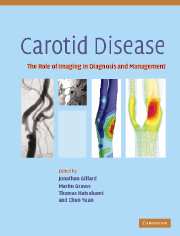Book contents
- Frontmatter
- Contents
- List of contributors
- List of abbreviations
- Introduction
- Background
- Luminal imaging techniques
- Morphological plaque imaging
- Functional plaque imaging
- Plaque modelling
- 23 The proximal carotid arteries – image-based computational modelling
- 24 Mechanical image analysis using finite element method
- Monitoring the local and distal effects of carotid interventions
- Monitoring pharmaceutical interventions
- Future directions in carotid plaque imaging
- Index
- References
23 - The proximal carotid arteries – image-based computational modelling
from Plaque modelling
Published online by Cambridge University Press: 03 December 2009
- Frontmatter
- Contents
- List of contributors
- List of abbreviations
- Introduction
- Background
- Luminal imaging techniques
- Morphological plaque imaging
- Functional plaque imaging
- Plaque modelling
- 23 The proximal carotid arteries – image-based computational modelling
- 24 Mechanical image analysis using finite element method
- Monitoring the local and distal effects of carotid interventions
- Monitoring pharmaceutical interventions
- Future directions in carotid plaque imaging
- Index
- References
Summary
Introduction
The carotid bifurcation is a site of particular interest for arterial disease studies, since it is a focal site where atherosclerosis is common, particularly affecting the carotid sinus, at the origin of the internal carotids. Moreover, as the atherosclerotic plaque forms, it may become vulnerable to rupture, releasing emboli and promoting the formation of thrombus more distally, leading to stroke.
The long-standing hypothesis that hemodynamic forces correlate with the initiation and progression of atherosclerosis has been the driver for numerous computational and experimental studies of the carotid arteries over the years. Research on the combination of magnetic resonance imaging (MRI) and computational fluid dynamics (CFD) began almost a decade ago, leading to subsequent publications on studies of large artery hemodynamics under physiologically realistic anatomical and flow conditions (Milner et al., 1998; Taylor et al., 1999; Long et al., 2000a, b; Wood et al., 2001). The use of conventional and 3D ultrasound imaging to acquire in vivo geometrical information for CFD analysis has not been widely adopted although some attempts have been made (Gill et al., 2000; Augst et al., 2003; Barratt et al., 2004; Glor et al., 2005). Computerised tomography (CT) imaging has also been used for reconstruction of subject-specific models of coronary stenoses and abdominal aortic aneurysms (Raghavan et al., 2000; Achenbach et al., 2001; Leung et al., 2005), but this technique is limited by the associated ionizing radiation.
- Type
- Chapter
- Information
- Carotid DiseaseThe Role of Imaging in Diagnosis and Management, pp. 313 - 323Publisher: Cambridge University PressPrint publication year: 2006



